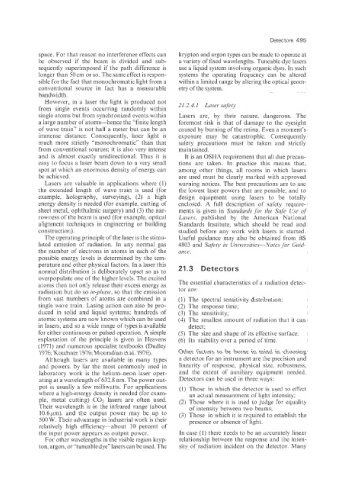Page 512 - Instrumentation Reference Book 3E
P. 512
Detectors 495
space. For that reason no interference effects can krypton and argon types can be made to operate at
be observed if the beam is divided and sub- a variety of fixed wavelengths. Tuneable dye lasers
sequently superimposed if the path difference is use a liquid system involving organic dyes. In such
longer than 50 cm or so. The same effect is respon- systems the operating frequency can be altered
sible for the fact that monochromatic light from a within a limited range by altering the optical geom-
conventional source in fact has a measurable etry of the system.
bandwidth.
However, in a laser the light is produced not
from single events occurring randomly within 21.2.4.1 Laser sqfetj
single atoms but from synchronized events within Lasers are, by their nature, dangerous. The
a large number of atoms-hence the “finite length foremost risk is that of damage to the eyesight
of wave tirain” is not half a meter but can be an caused by burning of the retina. Even a moment’s
immense distance. Consequently, laser light is exposure may be catastrophic. Consequently
much more strictly “monochromatic” than that safety precautions must be taken and strictly
from conventional sources; it is also very intense maintained.
and is almost exactly unidirectional. Thus it is It is an OSHA requirement that all due precau-
easy to focus a laser beam down to a very small tions are taken. In practice this means that.
spot at which an enormous density of energy can among other things, all rooms in which lasers
be achieved. are used must be clearly marked with approved
Lasers are valuable in applications where (1) warning notices. The best precautions are to use
the extended length of wave train is used (for the lowest laser powers that are possible, and to
example, holography, surveying), (2) a high design equipment using lasers to be totally
energy density is needed (for example, cutting of enclosed. A full description of safety require-
sheet metal, ophthalmic surgery) and (3) the nar- ments is given in Staizdardsfor the Safe Use of
rowiiess of the beam is used (for example, optical Lasers. published by the American National
alignment techniques in engineering or building Standards Institute. which should be read and
construction). studied before any work with lasers is started.
The operating principle of the laser is the stimu- Useful guidance may also be obtained from BS
lated emission of radiation. In any normal gas 4803 and Sajety in Ulzivei,sities-,liotes for Gziid-
the number of electrons in atoms in each of the ance.
possible energy levels is determined by the tem-
perature and other physical factors. In a laser this 21.3 Detectors
normal distribution is deliberately upset so as to
overpopullate one of the higher levels. The excited
atoms then not only release their excess energy as The essential characteristics of a radiation detec-
radiation but do so in-phase, so that the emission are:
from vast numbers of atoms are combiiied in a The spectral sensitivity distribution;
single wave train. Lasing action can also be pro- The response time;
dxed in solid and liquid systems; hundreds of The sensitivity;
atomic systems are now known which can be used The smallest amount of radiation that it can
in lasers, and so a wide range of types is available detect;
for either continuous or pulsed operation. A simple The size and shape of its effective surface:
explanation of the principle is given in Heavens Its stability over a period of time.
(1971) and numerous specialist textbooks (Dudley
1976; Koechner 1976; Mooradian etal. 1976). Other factors to be borne in mind in choosing
Although lasers are available in many types a detector for an instrument are the precision and
and powers. by far the most comionly used in linearity of response, physical size, robustness,
laboratory work is the helium-neon laser oper- and the extent of auxiliary equipment needed.
ating at a wavelength of 632.8 nm. The power out- Detectors can be used in three ways:
put is usually a few milliwatts. For applications (1) Those in which the detector is used to effect
where a high-energy density is needed (for exam- an actual measurement of light intensity;
ple, metal cutting) C02 lasers are often used. (2) Those where it is used to judge for equality
Their wavelength is in the infrared range (about of intensity between two beams;
10.6pm), and the output power may be up to (3) Those in which it is required to establish the
500 W. Their advantage in industrial work is their presence or absence of light.
relatively high efficiency-about 10 percent of
the input power appears as output power. In case (1) there needs to be an accurately linear
For other wavelengths in the visible region kryp- relationship between the response and the inten-
ton, argon, or “tuneable dye” lasers can be used. The sity of radiation incident on the detector. Many

